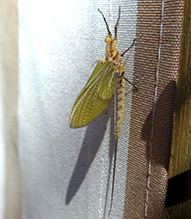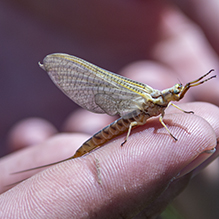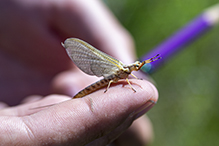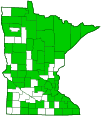giant mayfly
(Hexagenia limbata)
Conservation • Description • Habitat • Ecology • Distribution • Taxonomy
|
|
|||||||||||||
Description |
Giant mayfly is a large common burrower mayfly. It is very widespread, occuring in the United States and southern Canada from the east coast to the Great Plains and on the west coast. It is mostly absent from the desert and mountain regions in the west. It is the most common mayfly in the Midwest, and it is common in Minnesota. Larvae are found in organic, silty or mucky bottoms of lakes, ponds, and rivers, usually about three meters below the water surface. They feed on organic material suspended in the water. Immature adults (subimagos) are found on trees and bushes on shores near the bodies of water from which they emerged. Adults are found flying in swarms over land near the water body. The adult is soft-bodied and, as the common name suggests, large, 5⁄16″ to 1 1⁄16″ (8.3 to 27.3 mm) in length. It may be the largest mayfly in the United States. The female tends to be larger than the male and has smaller eyes. Color and markings are highly variable. It may be may be yellow, yellowish-brown, brown, or even white. The antennae are short, bristle-like, and inconspicuous. The mouth parts are small, poorly developed, and non-functional. There are two hair-like, very long, sensory appendages (cerci) at the tip of the abdomen. The cerci may be as long as the body. On the hind leg the last part of the leg (tarsus), corresponding to the foot, has 4 segments. The forewings are clear, large, triangular, and have many veins. They are held together above the body when at rest. There are five cross veins at the tip of each wing. The second terminal branch of the front (anterior) branch of the first fork of the media vein is designated as the M2 vein. The M2 extends downward at the base toward the first cubitus vein Cu1 then bends abruptly upward and continues straight to the outer margin. The hindwings are much smaller than the forewings. The R4+5 vein on the hindwing is not forked. |
Size |
Total length: 5⁄16″ to 1 1⁄16″ (8.3 to 27.3 mm) |
Similar Species |
Habitat |
Larvae are found in organic, silty or mucky bottoms of lakes, ponds, and rivers. Immature adults are found on trees and bushes on shores near the bodies of water from which they emerged. Adults are found flying in swarms over land near the water body. |
Ecology |
Season |
One generation per year, peaking in August. |
Behavior |
|
Life Cycle |
The female lays eggs on the water surface. Each egg sinks to the bottom where it overwinters. The nymph hatches in the spring. It creates a U-shaped tunnel in the sediment where it spends most of its life. It lives in the water from 6 months to 3 years, undergoing up to 30 molts. Eventually, it swims to the water surface while at the same time breaking through the larval skin. This subadult stage has functional wings and is called a subimago. It flies to nearby vegetation and molts one last time, emerging as an adult. Emergences are synchronized and can produce swarms so large that they can bee seen by weather satellites. Snow plows are sometimes used to clear dead mayflies off of roads. |
Larva Food |
Organic material suspended in the water. |
Adult Food |
Adults do not feed |
Distribution |
||
|
Sources |
|
| 9/1/2024 | ||
Occurrence |
||
Common Giant mayfly is one of the most widespread mayflies in North America and the most common mayfly in the Midwest. Local populations can be enormous. |
||
Taxonomy |
|
Order |
Ephemeroptera (mayflies) |
Suborder |
Furcatergalia |
Superfamily |
Ephemeroidea |
Family |
Ephemeridae (burrowing mayflies) |
Genus |
Hexagenia (giant mayflies) |
Subordinate Taxa |
|
|
|
Synonyms |
|
Ephemera limbata Hexagenia affiliata Hexagenia angulata Hexagenia californica Hexagenia carolina Hexagenia elegans Hexagenia kanuga Hexagenia limbata californica Hexagenia limbata limbata Hexagenia limbata occulta Hexagenia limbata venusta Hexagenia limbata viridescens Hexagenia marilandica Hexagenia mingo Hexagenia munda Hexagenia munda affiliata Hexagenia munda elegans Hexagenia munda marilandica Hexagenia munda munda Hexagenia occulta Hexagenia pallens Hexagenia rosacea Hexagenia variabilis Hexagenia venusta Hexagenia viridescens Hexagenia weewa Palingenia limbata Palingenia occulta Palingenia viridescens |
|
Common Names |
|
giant mayfly Michigan hex burrowing mayfly sandfly |
|
Glossary
Cercus
One of a pair of small sensory appendages at the end of the abdomen of many insects and other arthropods. In Odonata, one of the upper claspers. Plural: cerci.
Tarsus
On insects, the last two to five subdivisions of the leg, attached to the tibia; the foot. On spiders, the last segment of the leg. Plural: tarsi.
Visitor Photos |
||
Share your photo of this insect. |
||
This button not working for you? |
||
Nancy Lundquist |
 |
It was on our screen in West St Paul. |
Luciearl |
 |
MinnesotaSeasons.com Photos |
||
 |
 |

Visitor Videos |
||
Share your video of this insect. |
||
This button not working for you? |
||
|
Other Videos |
||
Largest USA Mayfly Metamorphosis Dun to Spinner (Hexagenia Limbata) |
About
Jul 23, 2014 Watch as a hex mayfly cracks out of it's dun stage and turns into a spinner right in front of my camera. |
Hexagenia Limbata (Hex) Mayfly Hatch |
About
Apr 5, 2011 A swarm of Hex mayfly spinners over a river in northern Wisconsin. |
Burrowing Mayfly (Ephemeridae: Hexagenia limbata) Female Subimago |
About
Aug 7, 2011 Photographed in Wisconsin, across the Mississippi River just North of Red Wing, Minnesota (04 August 2011). Thank you to Roger Rohrbeck (@Bugguide.net) for identifying this specimen! |

Visitor Sightings |
||
Report a sighting of this insect. |
||
This button not working for you? |
||
Nancy Lundquist |
Location: West St. Paul It was on our screen in West St Paul. |
 |
| Luciearl 7/1/2017 |
Location: Lake Shore, Mn |
MinnesotaSeasons.com Sightings |
||
Lac qui Parle WMA (Swift County) |

Created: 6/25/2021 Last Updated: © MinnesotaSeasons.com. All rights reserved. |



